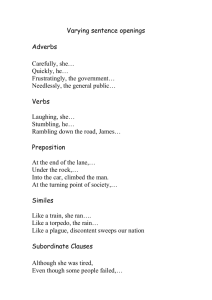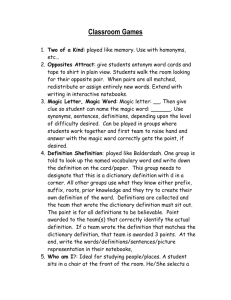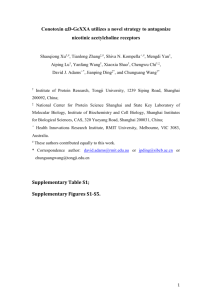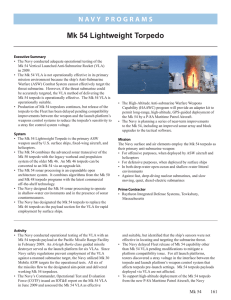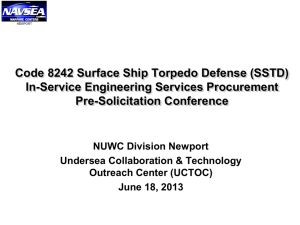A classic chase problem solved from a physics perspective Carl E Mungan
advertisement
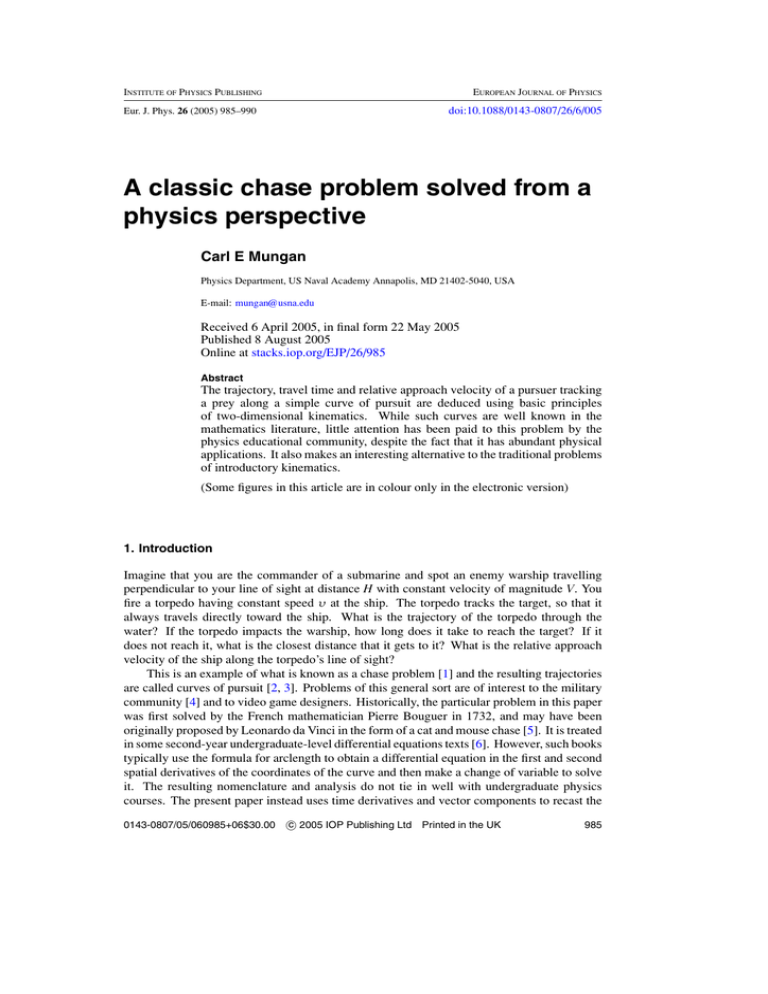
INSTITUTE OF PHYSICS PUBLISHING Eur. J. Phys. 26 (2005) 985–990 EUROPEAN JOURNAL OF PHYSICS doi:10.1088/0143-0807/26/6/005 A classic chase problem solved from a physics perspective Carl E Mungan Physics Department, US Naval Academy Annapolis, MD 21402-5040, USA E-mail: mungan@usna.edu Received 6 April 2005, in final form 22 May 2005 Published 8 August 2005 Online at stacks.iop.org/EJP/26/985 Abstract The trajectory, travel time and relative approach velocity of a pursuer tracking a prey along a simple curve of pursuit are deduced using basic principles of two-dimensional kinematics. While such curves are well known in the mathematics literature, little attention has been paid to this problem by the physics educational community, despite the fact that it has abundant physical applications. It also makes an interesting alternative to the traditional problems of introductory kinematics. (Some figures in this article are in colour only in the electronic version) 1. Introduction Imagine that you are the commander of a submarine and spot an enemy warship travelling perpendicular to your line of sight at distance H with constant velocity of magnitude V. You fire a torpedo having constant speed υ at the ship. The torpedo tracks the target, so that it always travels directly toward the ship. What is the trajectory of the torpedo through the water? If the torpedo impacts the warship, how long does it take to reach the target? If it does not reach it, what is the closest distance that it gets to it? What is the relative approach velocity of the ship along the torpedo’s line of sight? This is an example of what is known as a chase problem [1] and the resulting trajectories are called curves of pursuit [2, 3]. Problems of this general sort are of interest to the military community [4] and to video game designers. Historically, the particular problem in this paper was first solved by the French mathematician Pierre Bouguer in 1732, and may have been originally proposed by Leonardo da Vinci in the form of a cat and mouse chase [5]. It is treated in some second-year undergraduate-level differential equations texts [6]. However, such books typically use the formula for arclength to obtain a differential equation in the first and second spatial derivatives of the coordinates of the curve and then make a change of variable to solve it. The resulting nomenclature and analysis do not tie in well with undergraduate physics courses. The present paper instead uses time derivatives and vector components to recast the c 2005 IOP Publishing Ltd Printed in the UK 0143-0807/05/060985+06$30.00 985 986 C E Mungan y D B V L ship torpedo θ H C υ x A Figure 1. Trajectories of the torpedo and warship. Point A is the location of the torpedo when fired; point B indicates the initial position of the target; point C has coordinates (x, y) and denotes the current location of the torpedo; and point D with coordinates (V t, H ) is the current location of the ship. solution in terms of the more familiar concepts of velocity and acceleration. It then becomes an application of 2D kinematics. 2. First integral of the differential equation Set up a coordinate system with the torpedo starting at the origin and travelling initially in the y-direction and the warship steaming in the x-direction. At some arbitrary instant in time t (after firing the torpedo at t = 0), the positions of the ship and torpedo are as indicated in figure 1. The dashed right triangle has a base of length V t − x, height H − y and hypotenuse (representing the distance to the target) of length L. The ratio of the rise and run of this triangle is equal to the ratio of the y and x components of the torpedo’s velocity, because the torpedo is headed directly toward the ship, so that υx (1) V t − x = (H − y) . υy Differentiating both sides with respect to time and rearranging leads to υ 2 d d υx V υ2 = = −1=− ay , H −y dt υy dt υy υy2 υ 2 − υy2 (2) using the fact that υx2 + υy2 = υ 2 is a constant and introducing the y-component of the torpedo’s centripetal acceleration. In order to integrate this equation, one can substitute the chain-rule result, ay = υy dυy /dy, familiar from the derivation of the work-kinetic-energy theorem. The variables can then be separated and both sides integrated to obtain υy υ dυy V y dy , (3) =− υ 0 H −y υ υ υ2 − υ2 y y where the lower limits are the initial values. Computing these standard integrals, one gets −V /υ 2 − υ2 υ + υ + υ υ 2 − υy2 y y V y ⇒ = ln − ln 1 − = . (4) 1− υ H υy H υy A classic chase problem solved from a physics perspective 987 The quantity in the last set of parentheses appears so frequently in the remainder of this paper that it is useful to give it its own symbol, z ≡ 1 − y/H , in terms of which equation (4) can be rewritten as 2υ . (5) υy = −V /υ z + zV /υ This is the solution for the y-component of the torpedo’s velocity along its curve of pursuit. 3. Solving for other variables of interest Equation (5) can be used to readily solve for other physically interesting quantities. They will be expressed in terms of the dimensionless parameter z, which represents the normalized transverse distance from the ship to the torpedo. First, υx2 + υy2 = υ 2 leads to 1 − z2V /υ υx = . (6) υ 1 + z2V /υ Equations (5) and (6) can alternatively be compactly expressed in terms of hyperbolic functions. Next, to get the coordinates of the torpedo, note that υy = dy/dt so that equation (5) can again be separated and integrated to get y y −V /υ y V /υ 1 1− + 1− dy. (7) t= 2υ 0 H H cos θ = Provided that υ = V , the integrands are of the form z±n where n = 1, so that the result is t V + υ 1−V /υ V − υ 1+V /υ =− z z + + 1, (8) τ 2υ 2υ where τ is a characteristic time defined as Hυ τ≡ 2 (9) υ −V2 whose physical significance will become clear momentarily. Equation (8) gives the time that the torpedo needs to reach a given position. One can substitute that along with equations (5) and (6) into (1) to find 0.5 x 0.5 V /υ = z1−V /υ + z1+V /υ − 2 2 , (10) H V /υ − 1 V /υ + 1 V /υ − 1 which is the trajectory x(y) of the torpedo expressed in terms of the normalized quantities x/H , y/H = 1 − z and V /υ. This is plotted in figure 2 for several values of the speed ratio. The torpedo strikes the target when y = H ⇒ z = 0, which implies H V /υ ximpact = . (11) 1 − V 2 /υ 2 This is positive if and only if υ > V . As expected, the torpedo only hits if it is travelling faster than the ship! In that case, the time between launch and impact is ximpact /V = τ defined by equation (9). This impact time τ can be reduced if the torpedo leads [7] or, even better, mirrors [8] the ship’s motion rather than heading straight toward it. The distance between the torpedo and target at any time is υ (12) L = (V t − x)2 + (H − y)2 = (H − y) , υy using equation (1) in the second step. Substituting equation (5) then gives H L = (z1−V /υ + z1+V /υ ). 2 (13) 988 C E Mungan 1 1/5 1/2 1 y/H 0.8 2 0.6 5 0.4 0.2 0 0 0.5 1 1.5 2 x/H Figure 2. Graphs of equation (10) or (16) for 0 y H . The number on each curve labels the value of V /υ. Impact occurs if V /υ < 1, as is evident for the top two traces. The value zmin that gives the distance of closest approach Lmin for V > υ is found by setting dL/dz = 0, V − υ υ/2V V − υ υ/2V H zmin = ⇒ Lmin = . (14) V +υ 1 − υ 2 /V 2 V + υ As one might have guessed, the minimum separation is equal to H in the limit as V /υ → ∞ and occurs at t = 0. On the other hand, as V → υ, equation (14) has the limiting value Lmin → H /2 and this occurs as t → ∞. Assuming the torpedo does not actually hit the target, it can never get closer than this, regardless of its speed! The trajectory in this case is given by integrating equation (7) with V /υ = 1 to get H (1 − z2 − 2 ln z). 4υ Then, following the same reasoning used to derive equation (10), one deduces that t= √ x z2 − 1 = − ln z, H 4 plotted as the middle curve in figure 2. (15) (16) 4. Relative approach velocity of the target From figure 1, one can see that the ship is receding from the torpedo at speed V cos θ along the line of sight, while the torpedo is approaching along the same line at speed υ. Hence, the normalized relative approach velocity of the warship is υrel V = 1 − cos θ, (17) υ υ where cos θ is given by equation (6). This is plotted in figure 3 for the case of V /υ = 2. A positive value of υrel /υ indicates that the ship and torpedo are approaching one another; a negative value means they are receding. Therefore, the intercept along the horizontal axis represents the position of closest approach between the torpedo and target. This can be verified mathematically by substituting zmin from equation (14) into (6) to deduce the heading of the A classic chase problem solved from a physics perspective 989 1.0 υ rel /υ 0.6 0.2 -0.2 -0.6 -1.0 0 0.2 0.4 0.6 0.8 1 y/H Figure 3. Plot of the normalized relative approach velocity from equations (17) and (6) as a function of the normalized transverse position of the torpedo, for the case of V = 2υ. At y = 0, the torpedo’s heading is θ = 90◦ and thus υrel /υ = 1. On the other hand, as y → H , the torpedo falls in line behind the ship (since V > υ) so that θ = 90◦ and hence υrel /υ = −1. The horizontal ∼ 0.24. intercept is located at y/H = 1 − 3−1/4 = torpedo at minimum separation, υ −1 (18) θmin = cos V or 60◦ in the case of figure 3. This simple relation can alternatively be deduced by setting the time derivative of the first equality in equation (12) to zero, and then substituting equation (1) into it. In practice, the curve in figure 3 could be experimentally mapped out if the torpedo measures the Doppler shift in the tracking return signal. The classical Doppler shifted reflection frequency off the target is (u − V cos θ) (u + υ) , (19) f = f (u − υ) (u + V cos θ ) for a source of frequency f aboard the torpedo with a signal speed u through the water. (For example, in the case of Doppler sonar, f is typically of the order of hundreds of kilohertz and the sound speed u is about 1500 m s−1 in seawater.) The four terms in parentheses arise from the Doppler shifts in the signals: emitted by the moving source—first term in the denominator; received at the ship—first term in the numerator; echoed by the ship—second term in the denominator; and received back at the torpedo—second term in the numerator. For realistic torpedo and warship speeds, υ and V are much smaller than u, so that equation (19) can be approximated as f u ∼ V ∼ f 1 − 2 V cos θ + 2 υ ⇒ = 2 1 − cos θ , (20) f= u u f υ υ where f ≡ f − f . The left-hand side of the second equality is the normalized frequency shift divided by the Mach number of the torpedo. Meanwhile, the right-hand side is twice the normalized relative approach velocity of the target, according to equation (17). Hence, figure 3 directly gives the Doppler shift to within a constant scaling factor. In particular, zero shift represents the best opportunity for the torpedo to explode and attempt to inflict damage on the ship (assuming it has not already impacted it by then), which is the basis of proximity fuses. Similar spectral effects are exploited by ‘Doppler bats’, such as the horseshoe and pipistrelle, while chasing insects [9]. 990 C E Mungan 5. Extensions to related applications As an introduction to chase problems, this paper restricted consideration to the simple case of a quarry travelling at constant velocity followed by a pursuer travelling at constant speed. In this concluding section, a number of variations on this basic theme are listed. Interested readers are referred to the literature for further discussion of them. Many of them could form the basis for challenging student projects, well suited to computer simulation. Military pursuit. Anticipating the prey’s future location; targeting when firing bullets at the quarry; limiting the maximum acceleration (minimum radius of curvature); pursuit from a constant angle of attack; optimum search trajectories when a quarry’s location is only partially known; controlling the impact direction so that it is from the front or side; three-dimensional pursuit through the air or water. Gaming strategies. Chase in a confined space (such as a boxing ring); pursuit when the motion is constrained (such as on a chess board); preventing a quarry from reaching a refuge (as in tag); a runner launching at a moving target (as in dodgeball). Animal motions. Bugs on the vertices of a polygon each pursuing their nearest neighbour in a clockwise inward spiral [10]; a dog in flowing water who is following a runner on land; a spider scurrying along his web; a farmer trying to round up multiple escaped pigs. Mathematical analyses. Polar coordinates of the prey relative to the pursuer; quarry following a nonlinear plane curve and/or whose speed varies in a predictable manner; relationship to special curves such as the tractrix (shape of an initially straight chain whose end is dragged in a direction other than its initial axis) or caustic (envelope of reflected rays from a curved mirror); geodesic pursuit on a curved surface (e.g. a cylinder or hillside); chase on a rotating turntable. Acknowledgments I thank Brian Jenkins and Murray Korman for inspiring this paper. References [1] Behroozi F and Gagnon R 1979 The goose chase Am. J. Phys. 47 237–8 [2] Bernhart A 1954 Curves of pursuit Scr. Math. 20 125–41 Bernhart A 1957 Curves of pursuit II Scr. Math. 23 49–65 Bernhart A 1959 Polygons of pursuit Scr. Math. 24 23–50 Bernhart A 1959 Curves of general pursuit Scr. Math. 24 189–206 [3] Barton J C and Eliezer C J 2000 On pursuit curves J. Aust. Math. Soc. B 41 358–71 [4] Yuan L C 1948 Homing and navigational courses of automatic target-seeking devices J. Appl. Phys. 19 1122–8 [5] Guha A and Biswas S K 1994 On Leonardo da Vinci’s cat and mouse problem Bull. Inst. Math. Appl. 30 12–5 [6] For example, see Derrick W R and Grossman S I 1976 Elementary Differential Equations with Applications (Reading, MA: Addison-Wesley) [7] Dunbar S R 1994 Chase problems UMAP J. 15 351–6 [8] O’Connell J 1995 Pursuit and evasion strategies in football Phys. Teach. 33 516–8 [9] Denny M 2004 The physics of bat echolocation: signal processing techniques Am. J. Phys. 72 1465–77 [10] Watton A and Kydon D W 1969 Analytical aspects of the n-bug problem Am. J. Phys. 37 220–1
